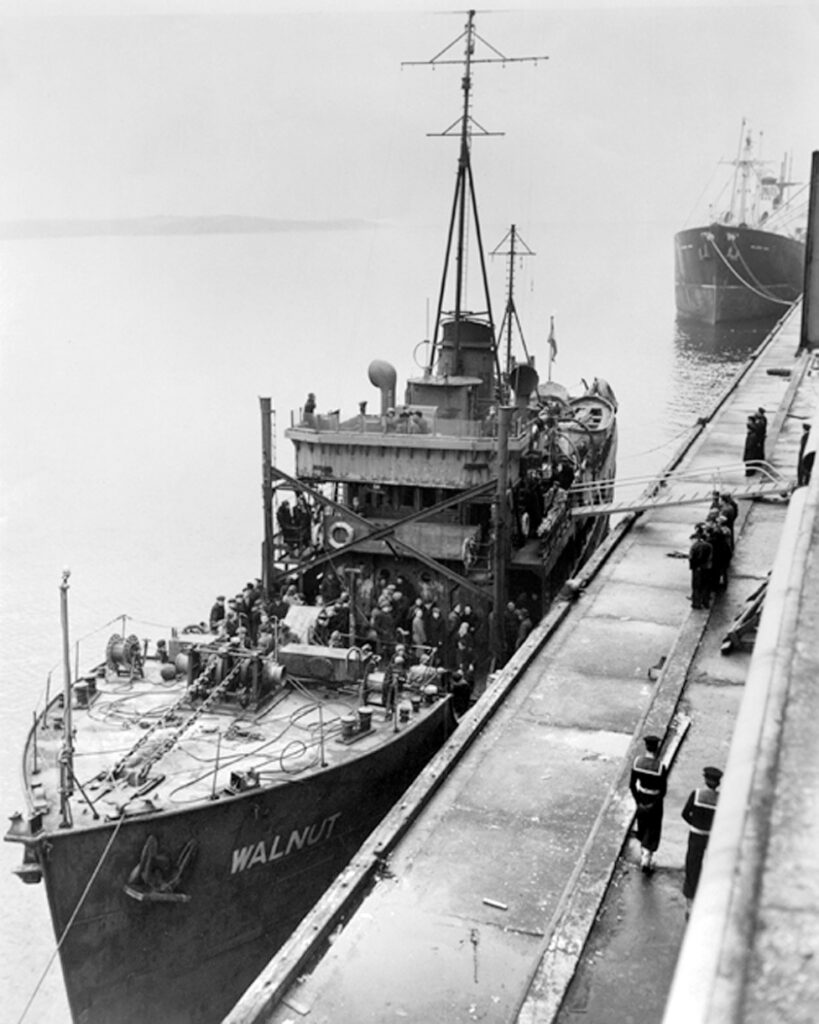Boats

The S.S. Walnut in Halifax harbor
s.s. walnut
With 352 people crammed on board, the S.S. Walnut carried the largest number of refugees on the Viking boats that left Sweden. After a difficult 28-day journey across the Atlantic, the ship arrived in Halifax, Canada, on December 13, 1948.
The Walnut was a 164-foot-long (50 meters) former British Royal Navy minesweeper, built in England in 1939. After World War II, such military ships were no longer needed and sold for commercial use. In 1948, Sten Olsson, who later became a freight shipping magnate, purchased three minesweepers and brought them to Sweden, intending to convert them for cargo. However, they were not suitable for freight, so the 550-ton Walnut went back on the market.
When a group of Estonian refugees in Sweden learned that the 9-year-old ship was for sale, they formed Compania Maritima Walnut S.A. (Shipping Company Walnut Ltd.) and raised 225,000 Swedish kronor (63,000 Canadian dollars) to buy it. Although the ship was slow with a top speed of 11.5 knots, the organizers knew it was seaworthy.

Walnut passengers leaving Sweden
The company’s directors included Alexander Kalbus, Helmut Suursööt, Voldemar Vares, and the Walnut’s captain, August Linde. The group sold 250 shares for 1,000 kronor each, a sum that covered the cost of retrofitting the ship, which originally was designed to accommodate 35 people. At first, the plan was to take 250 passengers, but as more refugees learned about the ship through word of mouth, the passenger list grew.
The Walnut departed Göteborg, Sweden, on November 13th, 1948, stopping in Lysekil to complete preparations. Four days later, the ship set off again with 352 people on board, 50 of them hidden inside the ship until it reached open waters because the Swedish authorities had authorized only 303 passengers.
Estonians made up the largest group of passengers, but Latvians, Lithuanians, Poles, Austrians, and Finns were also on board. According to Tiiu Roiser-Chorowiec, whose mother was a passenger, before the Walnut sailed, Swedish port officials received an urgent telegram from the Soviet authorities. The Soviet Union was actively pressuring the Baltic refugees whom they regarded to be Soviet citizens to return to their occupied homelands. Understanding that the telegram probably demanded that the Walnut be stopped from sailing, the Swedish officers waited until the ship left before opening the cable.
Conditions on board the Walnut were extremely crowded. The refugees were forced to spend most of their time in their bunks, which were two feet high (60 centimeters), two feet wide, and six feet long (1.8 meters). The oceans in the winter were very turbulent.
“Those trapped inside experienced body sensations akin to a roller-coaster ride that went on for hours, sometimes days,” wrote Lynda Mannik,* whose father and uncle were on board. Many of the passengers were seasick.

On December 27, 1948, TIME magazine in Canada wrote about the arrival of the Walnut.
The Walnut sailed into a heavy storm in the North Sea that washed 200 tons of reserve coal off its deck and caused the boiler room to flood. On November 23, the ship pulled into port in Sligo, Ireland, to make repairs and buy additional coal. Townspeople invited passengers into their homes for baths and meals. Four or five people left the ship in Ireland, including a crew member who disembarked because he wasn’t sure the boat would make it to Canada. On November 27, the Walnut continued its journey. Local residents, including a priest, came to the dock to pray for a safe journey and wave goodbye.
Crossing the Atlantic, the Walnut encountered more winter storms and lost its coal supply a second time. On December 10, it sailed into Sydney Harbor, Nova Scotia, where Canadian officials resupplied its coal reserves. Flying the Honduran flag, the ship then continued to Halifax immigration station, where earlier Viking boats had docked. The refugees immediately handed a letter to the authorities requesting political asylum. By mid-February, all but three passengers had been given security clearances. After three months in detention, most passengers had been released and allowed to remain in Canada. Only two people were sent back to Sweden.
Learn more about the Walnut and those on board in this video produced by Tiiu Roiser, daughter of one of the passengers.
*Lynda Mannik is the author of Photography, Memory, and Refugee Identity: The Voyage of the SS Walnut, 1948
